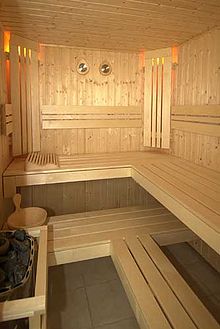Sauna
**History:**
– Saunas have been used since the Neolithic age, around 4000 B.C.E.
– Traditional Korean saunas date back to the 15th century.
– Western saunas originated in Finland, evolving from pits dug in the ground.
– The Industrial Revolution led to the evolution of saunas using wood-burning stoves.
– Sauna culture spread to Scandinavia and German-speaking regions after WWII.
**Design:**
– Saunas are designed for dry or wet heat sessions.
– They make bathers perspire due to high heat and steam.
– Sauna temperature is measured using a thermometer.
– Hygrometers can measure humidity levels in saunas.
– Infrared therapy is not considered a traditional sauna by Finnish organizations.
**Benefits:**
– Saunas are touted for their health benefits.
– Korean saunas were used to treat illnesses in the past.
– Saunas help relax muscles and improve circulation.
– Regular sauna use may reduce the risk of cardiovascular diseases.
– Saunas are believed to have detoxifying effects on the body.
**Cultural Significance:**
– Sauna culture is deeply rooted in Finnish and Estonian traditions.
– Finnish soldiers built saunas even in mobile tents during WWII.
– Korean sauna culture remains popular and widespread.
– Saunas have been valued in Baltic countries for centuries.
– Sauna traditions have been passed down through generations.
**Modern Saunas:**
– Electric sauna stoves were introduced in 1938.
– Sauna temperatures can range from 75–110°C (167–230°F).
– Sauna designs have evolved over time.
– Saunas are now equipped with chimneys for ventilation.
– Sauna culture remains prevalent in Finland, Baltic countries, and Scandinavia.
This article needs additional citations for verification. (December 2022) |
A sauna (/ˈsɔːnə, ˈsaʊnə/, Finnish: [ˈsɑu̯nɑ], Estonian: [ˈsɑu̯n]) is a room or building designed as a place to experience dry or wet heat sessions, or an establishment with one or more of these facilities. The steam and high heat make the bathers perspire. A thermometer in a sauna is typically used to measure temperature; a hygrometer can be used to measure levels of humidity or steam. Infrared therapy is often referred to as a type of sauna, but according to the Finnish sauna organizations, infrared is not a sauna.

